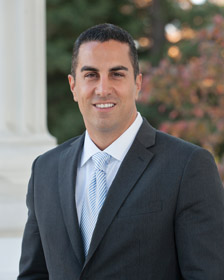
If you’re attending an outdoor wedding or walking a vineyard and hear the air buzzing with a subtle mechanical hum, chances are there’s a drone nearby. Officially known as unmanned aerial systems (UAS), these aircraft have no onboard pilot or passengers. Though drones have mostly been used for military purposes, they’re now making their way into everyday life for practical purposes such as crop management, aerial photography and 3-D mapping.
What’s more, 7-Eleven Inc. announced that it successfully completed the first drone delivery to a customer’s home in Reno, Nev., in July 2016, with the help of Reno-based Flirtey, a leading independent drone delivery service. During the 7-Eleven operation, a drone successfully transported Slurpees, a chicken sandwich, donuts, hot coffee and candy to the home of a family that placed the order. The delivery was conducted in celebration of the convenience store chain’s 89th birthday.
Drones are on the rise, and this commercial delivery was a milestone for the UAS industry, proving the devices serve a useful purpose, especially for those who are homebound. But having a machine travel through the air can cause problems, and increasing concerns about the flood of drones flown in the United States by hobbyists as well as those with commercial interests, have pushed government regulators to formulate specific rules to guide the drone revolution.
New FAA rules
Earlier this year, the Federal Aviation Administration (FAA) predicted in its annual forecast that the combined sales of hobbyist and commercial drones could surge from 2.5 million aircraft this year to 7 million in 2020. In response, the Department of Transportation and FAA finalized the first operational rules for routine commercial use of small, unmanned UAS in June, which took effect in August. According to the FAA, these rules open pathways towards fully integrating drones into the nation’s airspace while working to harness new innovations safely to spur job growth, advance critical scientific research and save lives. (See “Key Points of the New Regulations.")
“We’re part of a new era in aviation, and the potential for unmanned aircraft will make it safer and easier to do certain jobs, gather information and deploy disaster relief,” says U.S. Transportation Secretary Anthony Foxx in a prepared statement. “We look forward to working with the aviation community to support innovation while maintaining our standards as the safest and most complex airspace in the world.”
Meanwhile, two new bills in the California legislature will require drone owners to have accountability. One would require them to have insurance, require all drone packaging to include safety disclosures and FAA registration rules, and mandate that drones of a certain size (and those equipped with GPS capability) feature automatic shut-off technology. The other bill is designed to counter hit-and-run accidents. California Assemblyman Mike Gatto introduced The Drone Registration/Omnibus Negligence-Prevention Enactment (DRONE) of 2016 earlier this year. Currently, it’s passed the assembly and is in the senate waiting for approval.
The drone revolution
How are drones currently being used? Innovation is a hallmark of the unmanned aircraft industry, and people continue to create new uses for the technology, says Les Dorr, an FAA spokesperson.
One North Bay photographer, for example, has been using drones for the last four years to shoot everything from weddings and TV documentaries to car commercials; he’s been hired for aerial photography for about 20 years. “Drones are just an extension of aerial photography,” says Jesse Kaltenbach of Skyland Photography LLC in Petaluma, “and although they have all this baggage [when it comes to] military bombing, drones have a practical purpose.”
In July, Kaltenbach used a drone to shoot a wedding in an alley on Fern Street in San Francisco. Since the area was closed for the celebration, he was able to fly a drone in a public area. “It was incredible. They’d lined the alley with flowers draping down specially built 12-foot pillars,” he says. “The ceremony was held at one end of the alley, and the groom rode up the alley on a horse while the bride was waiting in a window looking out.”
According to Kaltenbach, filming the wedding with a drone was the key to documenting the event in a 4K high-resolution video. “A small drone is more nimble in a tight area, giving me more leeway,” he explains. “I was able to hand launch it and hand catch it.” In addition, Kaltenbach was able to fly the drone in the reception hall and ballroom to capture Indian-style dancers and acrobats performing. “The photos were a big hit,” he says.
Drone technology is also being used in Napa and Sonoma counties to monitor vineyards. Kaltenbach scans vineyards with a special infrared camera. With the help of his partner, Eli Delia, Kaltenbach recently scanned 400 acres in Ukiah. “I like to say I’m in the business of protecting wine,” says Kaltenbach, who’s originally from France and supports growing healthy grapevines.
Jackson Family Wines in Santa Rosa also uses drone technology to make sure their grapevines are getting enough water, which translates into sustainably grown grapes and a significant cost savings for the vineyard. “We’ve just started using drones across our vineyards in Sonoma County,” says Katie Jackson, vice president of sustainability and external affairs at Jackson Family Wines. “These high-resolution images help us to monitor vineyard health and pinpoint specific vine needs. It’s especially helpful in informing irrigation requirements. Efficient water management in our vineyard is essential to meeting our sustainability goals, and using drones as a resource to further understand our actual water needs can mean using less water for irrigation.”
The drone trend
Some hobbyists fly drones for the sheer fun of it, and one student’s experience with drones underscores their popularity and depicts the evolution of a hobbyist who’s now planning a career with the technology. Five years ago, Drew Kass, then a business student at Sonoma State University, watched a snowboarding video on YouTube, filmed with a drone, and decided to try the technology. “I had to buy a lot of accessories to make it work, but today you can buy a drone and fly it five minutes later.”
He began using his drone to photograph SSU’s campus and shot footage for more than a year. Says Kass, “It’s essentially the same as playing a video game: It requires smooth, concise movement with your fingers,” he says. “I’d go out later in the day, toward sunset, and if the clouds were a certain formation, I could tell if there was likely to be a colorful sunset. When I was about to graduate, I felt others should see this perspective of the campus,” says Kass. He presented the footage to Susan Kashack, who works in public affairs at SSU, and his drone video was officially uploaded to the university’s YouTube site during finals week in May. It also launched on SSU’s new website this fall.
Kass’ video also received hundreds of “likes” and “shares” on Facebook. Currently, his drone-produced film, Discover Sonoma State University, continues to get favorable feedback from students, alumni, parents and applicants. “It was a personal project that served as my closing experience at SSU, but I never intended it to create a lot of buzz,” says Kass, who graduated in May.
“The drone video has been useful for potential students and their families, especially those who aren’t able to get to the campus for a tour,” says Kashack, associate vice president of marketing and communications. “It not only gives viewers a sense of the campus, but shows the larger picture of the landscape of surrounding areas. Potential students tell us it gives them an opportunity to see if Sonoma State is a place where they could fit in.”
Privacy and hazard concerns
 While drones serve many practical purposes, use of this technology raises all sorts of privacy concerns and can cause significant physical damage if not monitored properly. According to the FAA, the new rules don’t specifically deal with privacy issues or regulate how drones gather data on people or property, but the agency is currently acting to address privacy considerations and encourages UAS pilots to check with local and state laws before gathering information through remote sensing technology and photography.
While drones serve many practical purposes, use of this technology raises all sorts of privacy concerns and can cause significant physical damage if not monitored properly. According to the FAA, the new rules don’t specifically deal with privacy issues or regulate how drones gather data on people or property, but the agency is currently acting to address privacy considerations and encourages UAS pilots to check with local and state laws before gathering information through remote sensing technology and photography.
As for causing serious harm or damage, it’s important that UAS pilots operate their aircraft carefully. The unintentional but improper use of a drone at a crowded venue could cause great harm, says I.C. Tillman, a business development manager for Santa Rosa-based Keysight Technologies. “If a hobbyist used a drone to take video at an event such as a Formula One race and lost control of the drone over part of the track, it could fall onto the course and possibly cause a crash,” explains Tillman. Such a crash could result in the loss of life or a substantial loss of revenue.
Drone technology can also be used with the intent to harm or make illegal deliveries. Says Tillman, “Some commercial drones have enough payload capacity that one or more could be used to deliver nuclear or chemical elements to soft targets.”
There have been numerous reports of the improper or illegal use of drones. In January 2015, NBC News reported that a drone crashed into a tree on the White House grounds, and the radar system in place to detect flying objects (such as planes, missiles and large UASs) failed to detect it. In August 2015, The Los Angeles Times reported the first drone-related cross-border drug seizure by U.S. law enforcement when 28 pounds of heroin were delivered from Mexico to the United States via drone. The two men who pled guilty were caught on border patrol cameras retrieving the drugs near California Highway 98. And in December last year, a Quebec newspaper, La Presse, reported that a handgun from Mexico was delivered to a Quebec prison via drone and prison authorities weren’t aware of it until a day later.
Earlier this year, the Obama Administration directed the National Telecommunications and Information Administration (NTIA) to work with a diverse group of stakeholders to develop UAS privacy best practices, according to the FAA.
Building on the NTIA’s best practices, the FAA will provide all drone users with recommended privacy guidelines in the UAS registration process and through the FAA’s B4UFly mobile app. The FAA will also educate all commercial drone pilots on privacy during their pilot certification process and will issue new guidance to local and state governments on drone privacy issues. For more information, go to www.ntia.doc.gov.
As drone technology continues to expand, so will the need to develop technologies to detect and locate them. Keysight Technologies in Santa Rosa offers drone detection solutions for commercial use and continues to develop new technology.
Says Tillman, “We’re adapting some of our spectrum monitoring technology for the specific purpose of detecting and locating drone controllers and video downlink signals. The concept is to create a protected area where drones can be detected and interdicted as they’re approaching and before they travel where harm can be done.”
The future of drones
The commercial drone business continues to evolve, and 7-Eleven’s milestone delivery is likely to pave the way for the future. But there are serious concerns as government regulators continue to draft rules to manage the use of this technology. Says Kass, “The technology has been changing rapidly in the past five years and now it’s easy for someone to buy a drone and fly it.
“A person in the wrong state of mind or who is under the influence [of drugs] can cause harm, for sure.”
As regulations continue to evolve, the FAA expects its new rules will help lead the way to fully integrating drones into the nation’s airspace. Meanwhile, the application of drone technology is working its way into academics. According to the FAA, college students are pursuing careers as engineers, computer scientists, pilots and even lawyers with the intent of applying their skills through drones, and the demand is generating new, college-level educational programs throughout the country. In California, some schools that offer such programs include California State University, Fresno, through the Lyles College of Engineering; California Polytechnic State University, Pomona; and the Sacramento-based Drone University USA offers classes in Los Angeles, San Francisco and San Diego.
While the current change in regulation doesn’t cover extended operations beyond visual line-of-sight and flight over people, the FAA is currently conducting research through an initiative called Pathfinder and is already working on new rules in these areas.
As for Kass, he’s planning to build his career around drone technology. “The future is wide open and I’m passionate about the technology and all its positive uses,” says Kass who currently works for a video production firm in San Francisco. “The younger generation is embracing it more, but the older generation is also using this technology. Despite age or background, anyone can find joy and pleasure in using drones, and this new technology has the potential to be an enormous industry.”
Drone Hoax
 In 2013, North Bay’s ABC Channel 7 news reported that Napa artist Stephen Whisler admitted he was the person behind a series of signs in Marin County that read, “Speed Enforced by Drones” and showed a missile firing from the craft. The signs appeared on Highway 101 as well as Highway 37.
In 2013, North Bay’s ABC Channel 7 news reported that Napa artist Stephen Whisler admitted he was the person behind a series of signs in Marin County that read, “Speed Enforced by Drones” and showed a missile firing from the craft. The signs appeared on Highway 101 as well as Highway 37.
According to the report, Whisler said the prank was a political statement on the use of drone spying and warfare. The California Highway Patrol investigated the incident. “[Whisler] was cooperative and forthcoming,” says Officer Andrew Barclay of California Highway Patrol’s Marin Area Office. “His intent was not to break the law or cause problems. He only wanted to make a political statement. We educated him on the laws applicable to posting fake signs on freeways, returned his property and no charges were filed."
Key Points of the New Regulations
The Department of Transportation and Federal Aviation Administration (FAA) have jointly released the first operational rules for routine commercial use of drones. The rules are designed to minimize the risks to other aircraft, people and property on the ground. They also offer safety regulations for unmanned aircraft drones weighing less than 55 pounds that are conducting nonhobbyist operations, such as for use in agriculture, bridge inspections, wildlife surveys and more. Here are a few key points of the new regulations:
• The person flying the drone must be at least 16 years old and have a remote pilot certificate with a small UAS rating or be directly supervised by someone with a certificate;
• Pilots are required to keep an unmanned aircraft within visual line of sight; and
• Operations are allowed during daylight and twilight, if the drone has anti-collision lights.
The new regulations also address height and speed restrictions and other operational limits, such as prohibiting flights over unprotected people on the ground who aren’t directly participating in the UAS operation. However, the FAA is offering a process to waive some restrictions if an operator proves the proposed flight will be conducted safely under a waiver. For more information go to www.faa.gov.
Did You Know?
Before the Federal Aviation Administration finalized the first operational rulings in June, the organization issued more than 7,100 case-by-case authorizations for commercial drone use in these areas:
• TV and video production;
• Precision agriculture;
• Bridge inspection;
• Real estate;
• Wildlife surveys;
• Aerial mapping;
• News gathering; and
• Search-and-rescue operations.
Drone Trends
In March 2016, BI Intelligence, a premium research service of Business Insider, released a detailed drone report that forecasts sales revenues for consumer, enterprise and military drones. The report details several of the world’s major drone suppliers and examines trends in drone adoption among several leading industries. Here are a few takeaways from the report:
• Revenues from drone sales are projected to top $12 billion in 2021;
• Shipments of consumer drones will more than quadruple over the next five years;
• Technologies such as geo-fencing and collision avoidance will make flying drones safer and make regulators more comfortable with a larger numbers of drones taking to the skies;
• The military sector will continue to lead all other sectors in drone spending, as a result of the high cost of military drones and the growing number of countries seeking to acquire them.
Source: www.businessinsider.com





